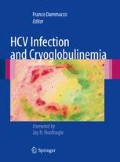Abstract
The pathogenesis of the vasculitic lesions due to hepatitis C virus (HCV)-associated mixed cryoglobulinemia (MC) involves leukocyte adhesion to endothelial cells. We have studied the three endothelial adhesion molecules primarily involved in leuko-endothelial adhesion, namely ICAM-1, VCAM-1, and ELAM-1. Soluble VCAM-1 was found in high concentrations in the serum of HCV-MC patients while in nerve biopsies from HCV-MC patients with more severe forms of the disease VCAM-1 was detected in the perineural vessels. In vitro stimulation of human umbilical vein endothelial cells with cryoprecipitates purified from HCV-MC serum mainly induced the expression of VCAM-1 and ELAM-1 expression on the endothelial cell surface, in a mechanism likely to involve C1q, which was detected in all cryoprecipitates. Thus, in agreement with recent of a role for VCAM-1 in several animal models of immune-complex-mediated-diseases, these data suggest that VCAM-1 is involved in the pathogenesis of HCV-MC vasculitis.
Access this chapter
Tax calculation will be finalised at checkout
Purchases are for personal use only
References
Butcher EC (1991) Leukocyte-endothelial cell recognition: three (or more) steps to specificity end diversity. Cell 67:1033–1036
Springer TA (1994) Traffic signals for lymphocyte recirculation and leukocyte emigration: the multistep paradigm. Cell 76:301–314
Tedder TF, Li X (1999) The selectins and their ligands: adhesion molecules of the vasculature. Adv Mol Cell Biol 28:65–111
Kaplanski G, Marin V (1998) Thrombin-activated human endothelial cells support monocyte adhesion in vitro following expression of intercellular adhesion molecule-1 (ICAM-1) and vascular cell adhesion molecule-1 (VCAM-1). Blood 92:1259–1267
Cacoub P, Renou C (2000) Extrahepatic manifestations associated with hepatitis C virus infection. A prospective multicenter study of 321 patients. Medicine 79:47–56
Dammaco F, Sansonno D (2001) The cryoglobulins: an overview. Eur J Clin Invest 31:628–638
Charles E, Dustin LB (2009) Hepatitis C virus-induced cryoglobulinemia. Kidney Int 76:813–824
Cacoub P, Maisonobe T (2001) Systemic vasculitis in patients with hepatitis C. J Rheumatol 28:109–118
Kaplanski G, Maisonobe T (2005) Vascular cell adhesion molecule-1 (VCAM-1) plays a central role in the pathogenesis of severe forms of vasculitis due to hepatitis C-associated mixed cryoglobulinemia. J Hepatol 42:334–340
Mulligan MS, Watson SR (1993) Protective effects of selectin chimeras in neutrophil-mediated Lung injury. J Immunol 151:6410–6417
Mulligan MS, Wilson GP (1993) Role of β1, β2 integrins and ICAM-1 in lung injury after deposition of IgG and IgA immune complexes. J Immunol 150:2407–2417
Ballardini G, Groff P (1995) Hepatitis C virus (HCV) genotype, tissue HCV antigens, hepatocellular expression of HLA-a, B, C and intercellular adhesion-1 molecules clues to pathogenesis of hepatocellular damage and response to interferon treatment in patients with chronic hepatitis C. J Clin Invest 95:2067–2075
Bernacchi E, Civita LL (1999) Hepatitis C virus (HCV) in cryoglobulinaemic leukocytoclastic vasculitis (LCV): could the presence of HCV in skin lesions be related to CD8+ lymphocytes, HLA-DR and ICAM-1 expression? Exp Dermatol 95:2067–2075
Norman U, Van De Velde NC (2003) Overlapping roles of endothelial selectins and vascular cell adhesion molecule-1 in immune complex-induced leukocyte recruitment in the cremasteric microvasculature. Am J Pathol 163:1491–1503
Burns JA, Issekutz TB (2001) The a4b1 (very late antigen VLA-4, CD49d/CD29) and α5β1 (VLA-5, CD49e/CD29) integrins mediate β2 (CD11/CD18) integrin-independent neutrophil recruitment to endotoxin-induced lung inflammation. J Immunol 166:4644–4649
Bowden RA, Ding ZM (2002) Role of α4 integrin and VCAM-1 in CD18-independent neutrophil migration across mouse cardiac endothelium. Circ Res 90:562–569
Johnston B, Kubes P (1999) The α4-integrin: an alternative pathway for neutrophil recruitment? Trends Immunol 20:545–550
Pereira S, Zhou M (2001) Resting murine neutrophils express functional a4 integrins that signal through Src family kinases. J Immunol 166:4115–4123
Shang T, Yednock T (1999) α9β1 Integrin is expressed on human neutrophils and contributes to neutrophil migration through human lung and synovial fibroblast barriers. J Leukoc Biol 66:809–816
Ross EA, Douglas MR (2006) Interaction between integrin α9β1 and vascular cell adhesion molecule-1 (VCAM-1) inhibits neutrophil apoptosis. Blood 107:1178–1183
Kaplanski G, Marin V (2002) Increased soluble p55 and p75 tumor necrosis factor-α receptors in patients with hepatitis C-associated mixed cryoglobulinemia. Clin Exp Immunol 127:123–130
Saadoun D, Bieche I (2007) Role of matrix matalloproteinases, proinflammatory cytokines, and strees-derived molecules in hepatitis C virus-associated mixed cryoglobulinemia vasculitis neuropathy. Arthritis Rheum 56:1315–1324
Antonelli A, Ferri C (2009) Serum levels of proinflammatory cytokines interleukin-1β, interleukin-6, and tumor necrosis factor α in mixed cryoglobulinemia. Arthritis Rheum 60:3841–3847
Antonelli A, Ferri C (2008) High values of CXCL10 serum levels in mixed cryoglobulinemia associated with hepatitis C infection. Am J Gastroenterol 103:2488–2494
Kaplanski G, Marin V (2003) IL-6: a regulator of the transition from neutrophil to monocytic inflammation. Trends Immunol 24:25–29
Kittlesen DJ, Chianese-Bullock KA (2000) Interaction between complement receptor gC1qR and hepatitis C virus core protein inhibits T-lymphocyte proliferation. J Clin Invest 106:1239–1249
Sansonno D, Tucci FA (2009) Role of the receptor for the globular domain of C1q protein in the pathogenesis of hepatitis C virus-related cryoglobulin vascular damage. J Immunol 183:6013–6020
Author information
Authors and Affiliations
Corresponding author
Editor information
Editors and Affiliations
Rights and permissions
Copyright information
© 2012 Springer-Verlag Italia
About this chapter
Cite this chapter
Kaplanski, G. (2012). The Role of VCAM-1 in the Pathogenesis of Hepatitis-C-Associated Mixed Cryoglobulinemia Vasculitis. In: Dammacco, F. (eds) HCV Infection and Cryoglobulinemia. Springer, Milano. https://doi.org/10.1007/978-88-470-1705-4_14
Download citation
DOI: https://doi.org/10.1007/978-88-470-1705-4_14
Published:
Publisher Name: Springer, Milano
Print ISBN: 978-88-470-1704-7
Online ISBN: 978-88-470-1705-4
eBook Packages: MedicineMedicine (R0)

